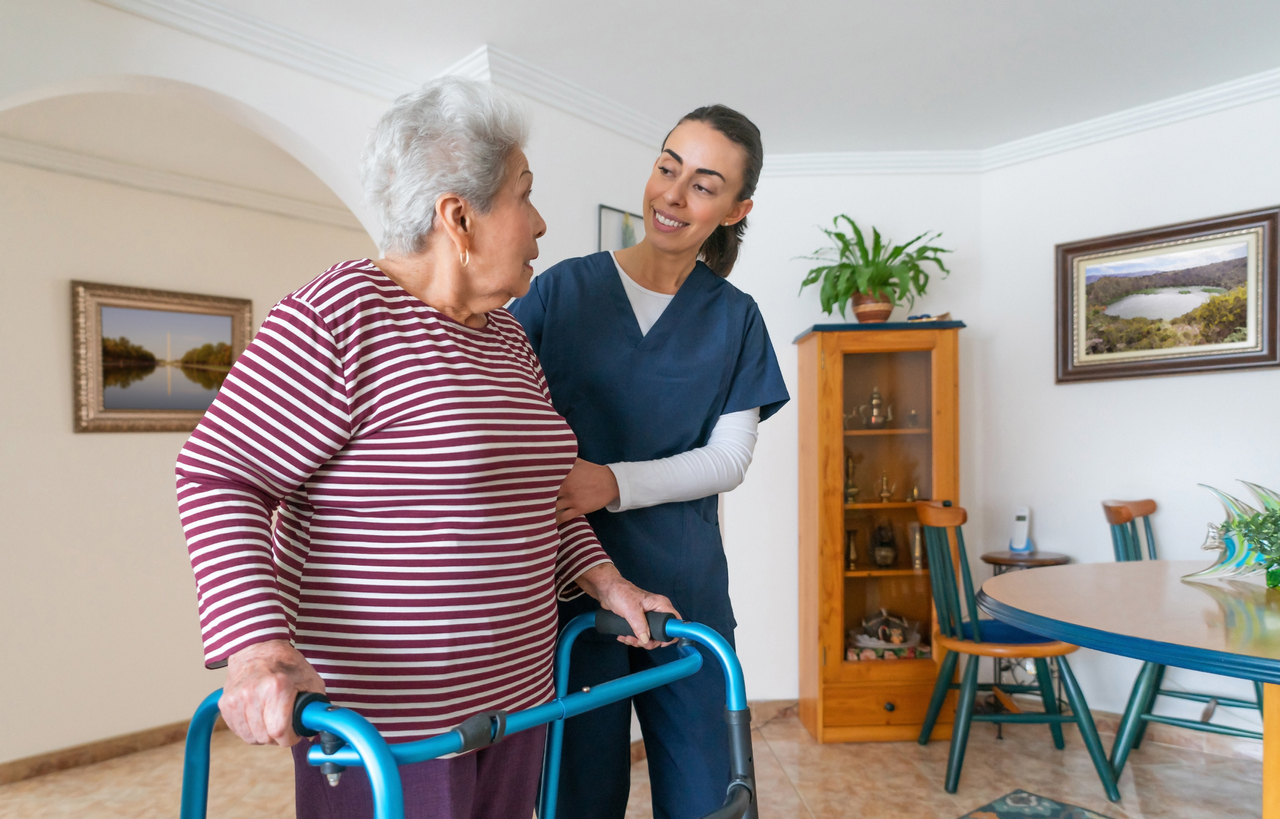A Guide to Caring for Older Adults
Written by:
University of Tulsa
• Jan 22, 2024

A Guide to Caring for Older Adults
The U.S. is entering an era when there will be an unprecedented volume of adults aged 65 and older. This is a strong indication that people are living longer, which is a good thing. It also presents a unique challenge for health care professionals, as the health care needs of older people demand complex care delivery strategies to optimize and maintain their overall health.
To meet this challenge, nurses must deploy strategies that provide holistic patient care for older adults. This type of care aims to address and treat the patient’s current needs as it also promotes proactive care that keeps them healthy, safe, and comfortable. Caring for older adults in this manner requires developing a deep knowledge of the demographic’s health needs and the tools they can use to help their patients live their best lives.
The Older Population at a Glance
The over-65 population in the U.S. is growing at unprecedented volume and is showing no signs of slowing down. The U.S. Census Bureau indicates that the U.S. population increased almost five times faster than the entire population from 1920 to 2020. The bureau also indicated that 1 in 10 Americans, or about 33.1 million people, was between the ages of 65 and 74 in 2020.
While the bureau projects a slowdown in this rate by 2030 — the year that all baby boomers will be at least 65 — its most recent population projections still indicate that the number of adults 65 and older will rise to 73.1 million, or roughly 21% of the population. The bureau also projects this number to be 94.7 million by 2060.
Drilling down further into the data reveals that the population is not only getting older but also living much longer. While the bureau indicated that the 75-to-84 age group grew by 25.1% between 2010 and 2020, it predicts the percentage to increase as new boomers continue to age. The bureau also noted that the U.S. had 5.7 million people aged 85 to 94 and 631,000 people aged 95 and older in 2020.
From a health care standpoint, these numbers indicate a need to sufficiently plan for this growth by preparing strategies to meet the needs of this demographic. Failure to do so will negatively impact a facility’s ability to reach its goal of providing care that improves patient outcomes.
Why Is Caring for Older Adults So Important?
Aging increases the risk of several chronic diseases in an individual, and the growth in the aging population may mean a higher prevalence of these chronic conditions. A 2022 study published by Frontiers in Health projected that by 2035, more than 70 million people between the ages of 60 and 79 will have at least one chronic condition, and nearly 7.5 million more in this age group will have more than one.
The more common chronic diseases include the following:
- Cancer
- Heart disease
- Type 2 diabetes
- Arthritis
- Dementia
Helping older adults properly manage and potentially mitigate these chronic conditions is important. Doing so can help patients stay healthy and help them save money. Unfortunately, chronic disease treatment can be costly for older Americans. The average annual costs per person of the most expensive conditions include the following:
- Dementia and Alzheimer’s disease — $48,701
- Cancer — $30,028
- Diabetes — $20,137
A greater number of older adults also means a greater potential for care delivery issues aimed at the older adult demographic. Caring for older adults can include assisted living care, in-home elderly care, and palliative care. In these cases, optimal care can involve ensuring that the patient’s end-of-life journey is as comfortable and dignified as possible.
From a health care perspective, the common thread that ties these unique conditions together is the need to deliver the best patient care possible. What this may look like depends on the patient and their needs; therefore, nurses need to be prepared to deliver a wide range of care.
How to Care for Older Adults
Properly caring for older adults requires a deep knowledge of the different types of care available to them. For advanced practice nurses, such as adult gerontology acute care nurse practitioners, this knowledge can help them not only provide the proper care that’s needed but also realize when it may be time to adapt their care strategies as health conditions evolve.
Assisted Living
Assisted living is a community-based residential option that allows patients varying levels of independence while receiving some assistance for activities such as meal preparation and housekeeping. These communities typically feature on-site medical support that can help provide care at a moment’s notice.
Home Health Care
Home health care helps patients live as independently as possible. While this can mean assisting with chores for patients with minimal issues, it can also mean assisting with daily activities, such as eating, bathing, and dressing. In these latter scenarios, skilled nurses can help patients regulate their health in different ways, such as monitoring medication use.
Adult Day Health Care
Adult day health care services are devoted to providing health, social, and therapeutic services to older adults. They can provide older patients with a sense of community without a permanent care facility placement. They can also support families that may be caring for an older adult at home.
Skilled Nursing Facility Care
Skilled nursing facilities , also known as nursing homes, provide high-level patient care for older patients. Some facilities feature specialized memory care units to help patients with various dementias, such as Alzheimer’s disease. Nurses at these facilities may provide more hands-on care than those at facilities with more patient independence.
Palliative Care
Palliative care is specialized care designed to help people with serious illnesses, such as cancer. This type of care focuses on comfort and quality of life, but it also allows enough room for nurses and other health care professionals to seek solutions to potentially cure the patient’s conditions.
Hospice Care
Hospice care is care that emphasizes quality of life and comfort at the end of a patient’s life. Unlike palliative care, attempts to find solutions that can cure a patient cease in hospice care . A hospice nurse typically works with multiple professionals to deliver optimal care for patients, including physicians and spiritual advisers.
Resources
Below are some resources that can help those caring for older adults.
- U.S. Department of Health and Human Services : This government agency provides links to help people find care solutions by ZIP code and links to state resources.
- Substance Abuse and Mental Health Services Administration : This organization provides resources for older patients with substance misuse and mental disorders.
- Eldercare Directory : This repository contains links to government programs, long-term care options, and health topics common among older patients.
Caring for Older Adults: Tips and Strategies
Providing care for older adults means using approaches that are less present in other demographics. These strategies can focus on encouraging healthy living, but they can also cause nurses to lean into their soft skills to create trust in the nurse-patient relationship.
Promotion of Patient Wellness
Encouraging older patients to adopt healthy behaviors can help them not only live longer but also thrive. These behaviors when executed consistently can help them live more independently, which can keep their quality of life at a higher level.
While nurses can create guidelines to help older patients make wise decisions about their health, loved ones can also make sure that such behaviors are made routinely. These behaviors include the following:
- Minimize social isolation. Poor health and the loss of a spouse and longtime friends can lead to isolation. This can cause loneliness, which can increase the risk of other health issues. Helping older individuals to remain in contact with family or seek out new friends with shared interests can help them be active, involved, and ultimately healthier.
- Encourage physical activity. Daily physical activity reduces stress and decreases depression as it improves sleep and improves balance. It can also help ward off chronic issues that may make it tougher to remain mobile over time. This activity doesn’t need to be too physically exerting — walking around the neighborhood or light aerobic activity will work well.
- Promote healthy eating. Eating right can keep bones strong and muscles sturdy. This can help an older person maintain balance and minimize the risk of the kind of falls that can hinder independence. Encouraging a diet of whole grains, vegetables, fruits, lean proteins, and healthy fats can also mitigate the risk of chronic health disease and improve immunity.
- Encourage regular checkups. Routine appointments with a doctor — or a nurse practitioner in some states — can help older patients keep strict tabs on vital signs that can indicate chronic health issues. These checkups can also make it easier to detect potential health hazards early before they become major issues.
Soft Skills and Older Patients
It can be common for nurses to interact with the same group of older patients. Because of this familiarity, it becomes important for nurses to know how to use soft skills to their advantage. These skills can include the following:
- Strong communication. Effective communication can demonstrate a sense of understanding, which can help put older patients at ease. This includes a particular emphasis on body language, as older patients may pick up on nonverbal cues that they may interpret as disinterest.
- Active listening. Paying close attention to what an older patient says can provide nurses with a clear picture of their health and how effective treatment is. This tactic also involves being respectful of their thoughts or feelings by not interrupting them or cutting them off to make a point.
- Empathy. Treating each case empathetically allows nurses to convey a sincere, caring attitude that acknowledges a patient’s humanity. This can also help a nurse build rapport, which can make it easier for patients to follow a nurse’s advice.
Resources
Nurses and other health care professionals can use the following resources when caring for older adults:
- National Institute on Aging : This organization provides links to resources that can help nurses and health care professionals approach care for individuals with different dementias.
- Hartford Institute for Geriatric Nursing : This organization provides a tool that allows nurses to develop strategies by entering various protocols and symptoms.
- AgingCare : This organization provides the materials and equipment that older patients may need in their homes to help them live independently longer.
A Rewarding, Enriching Activity
Caring for older adults presents a unique set of challenges. However, savvy nurses can rely on their knowledge and skills to overcome these hurdles to develop a trusted patient bond in a wide range of care settings. Successfully managing this type of care can leave nurses feeling accomplished and satisfied, simply because they helped improve an older patient’s day.


